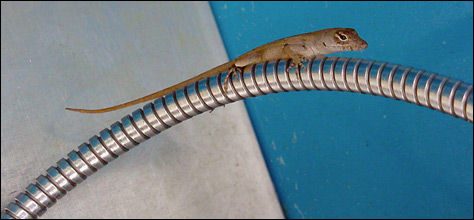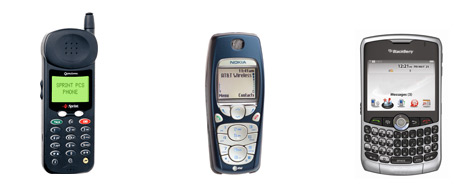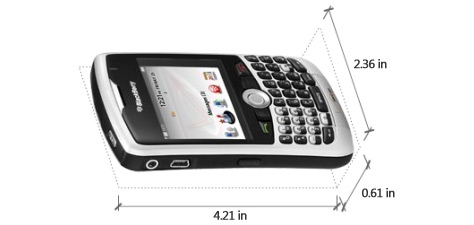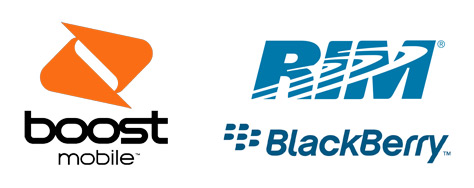 When the topic of cellular telephones came up in my presence, people were often surprised to learn that I did not have one. Instead of the whole story, I would usually explain that I had good cause to cancel my last service and simply found no need to get another mobile. After all, I had a landline to use with DSL internet and did most of my talking at home anyway (see "The Paradigm Shift").
People thought I was crazy. In our modern times, it was difficult for some to imagine their lives without the convenience of smartphones. Plus it was rather inconsistent with my technical persona. If it was not for the work-issued phone I had at the time, the people I met in San Francisco might have excommunicated me or something. I mean, even the homeless there have cell phones.
It all came down to a single straightforward issue: carrier contracts. Twice I had subscribed to cellular service and twice I was on the losing end of the deal.
My first phone was the Qualcomm QCP-2760 on Sprint PCS. I was pleased with the device and service but I later found myself without a job. As I was unable to make the payments, Sprint PCS terminated my account and charged me the early termination fee. I was unable to come to any arrangement with them and so when I did get my finances in order, I went with another carrier.
That carrier was AT&T Wireless and I used the Nokia 3595. Since I had no reason to switch, I continued on a month-to-month basis after my two-year contract ended. Unfortunately, AT&T Wireless started accepting bids for acquisition in 2004. I was not pleased when Cingular took things over, but the deal breaker came when I wanted to add more minutes to my monthly allotment. They said I could do nothing to my "legacy customer" plan without signing a new two-year contract.
When the topic of cellular telephones came up in my presence, people were often surprised to learn that I did not have one. Instead of the whole story, I would usually explain that I had good cause to cancel my last service and simply found no need to get another mobile. After all, I had a landline to use with DSL internet and did most of my talking at home anyway (see "The Paradigm Shift").
People thought I was crazy. In our modern times, it was difficult for some to imagine their lives without the convenience of smartphones. Plus it was rather inconsistent with my technical persona. If it was not for the work-issued phone I had at the time, the people I met in San Francisco might have excommunicated me or something. I mean, even the homeless there have cell phones.
It all came down to a single straightforward issue: carrier contracts. Twice I had subscribed to cellular service and twice I was on the losing end of the deal.
My first phone was the Qualcomm QCP-2760 on Sprint PCS. I was pleased with the device and service but I later found myself without a job. As I was unable to make the payments, Sprint PCS terminated my account and charged me the early termination fee. I was unable to come to any arrangement with them and so when I did get my finances in order, I went with another carrier.
That carrier was AT&T Wireless and I used the Nokia 3595. Since I had no reason to switch, I continued on a month-to-month basis after my two-year contract ended. Unfortunately, AT&T Wireless started accepting bids for acquisition in 2004. I was not pleased when Cingular took things over, but the deal breaker came when I wanted to add more minutes to my monthly allotment. They said I could do nothing to my "legacy customer" plan without signing a new two-year contract.
 For the next three years, ten months and twenty-one days, I did without cell service and did not particularly feel I was missing anything. When encountering a situation where it would have been useful, I was more apt to turn my nose because of the way people behave with telephones in stores and behind the wheel. Since the rudeness of other people is no reason to deny oneself technological convenience, I was open to the idea of another phone when a friend at work mentioned Boost Mobile and their prepaid BlackBerry plan.
Given my prior experience, I was a bit skeptical when I learned Boost was a subsidiary of Sprint. There were at least three reasons why I felt compelled to give them another shot. First, my original dispute with Sprint PCS was over a contract and this is prepaid. Second, the Sprint CDMA network seems to have come along in the past decade and is now the third largest in the US. Third and perhaps most surprising, I was impressed by the Kai Ryssdal interview of Sprint CEO Dan Hesse on Marketplace.
I also understand that Boost is targeting a demographic that is largely unable to get mobile service by contract due to poor credit history and other financial troubles. It occurs to me now I might very well be the Boost customer with the highest credit score. Nevertheless, none of that matters as long as the device and network are capable of providing the desired services.
For the next three years, ten months and twenty-one days, I did without cell service and did not particularly feel I was missing anything. When encountering a situation where it would have been useful, I was more apt to turn my nose because of the way people behave with telephones in stores and behind the wheel. Since the rudeness of other people is no reason to deny oneself technological convenience, I was open to the idea of another phone when a friend at work mentioned Boost Mobile and their prepaid BlackBerry plan.
Given my prior experience, I was a bit skeptical when I learned Boost was a subsidiary of Sprint. There were at least three reasons why I felt compelled to give them another shot. First, my original dispute with Sprint PCS was over a contract and this is prepaid. Second, the Sprint CDMA network seems to have come along in the past decade and is now the third largest in the US. Third and perhaps most surprising, I was impressed by the Kai Ryssdal interview of Sprint CEO Dan Hesse on Marketplace.
I also understand that Boost is targeting a demographic that is largely unable to get mobile service by contract due to poor credit history and other financial troubles. It occurs to me now I might very well be the Boost customer with the highest credit score. Nevertheless, none of that matters as long as the device and network are capable of providing the desired services.
 It is a simple setup. I bought the RIM BlackBerry Curve 8330 running OS 5 for $200 plus a $30 limited warranty to replace things like the mini trackball and battery. Each month, I add $60 to my Boost account by purchasing credits online. Although there are no additional fees, $4.50 in sales tax is levied when buying credits. This plan includes unlimited voice, SMS, MMS and data plus BlackBerry internet, messaging and GPS. In comparison, Verizon Wireless currently charges $90 for unlimited voice, SMS and MMS plus $30 for unlimited data. That comes to $60 or 100% more per month plus tax!
Comfortable enough with Google Voice after eight months of use, I advertised it as my new mobile number and decided not to use, learn or give out the device's assigned number. There have been only a few minor issues along the way, like when my friend Marc could not call my Google Voice number from his Virgin mobile although we could text each other and I could call him. His switching carriers resolved that. Google Voice also has trouble establishing outgoing calls if my signal is too weak, though incoming calls are not affected.
The experience has been quite positive overall and I have to admit to better understanding the reactions I got from people during my four disconnected years. I love being connected to my website and e-mail, and being able to approve comments while on the go. I love having GPS and maps in my pocket. In addition, I have been experimenting with Twitter—as you can see in the new window on the right—a service I never really understood before. I even added a new Flickr set to handle random mobile pictures. To my friends who have done all of these for many years, you may now roll your eyes.
Unless you play in the walled garden, keeping everything synched up can be a hassle. Fortunately, my current configuration between the computer, phone and Google is only slightly convoluted. Since I started using Google Contacts as my address book to get the most out of Google Voice, it was a simple matter to install Google Sync and copy all my contacts to the BlackBerry. Because Google uses one field for all address information, I added carriage returns to the entries so they would import correctly into separate fields (Address 1, Address 2, City, State, ZIP, Country). Getting the address book into Outlook 2010 is currently a manual process using Google's export feature.
It is a simple setup. I bought the RIM BlackBerry Curve 8330 running OS 5 for $200 plus a $30 limited warranty to replace things like the mini trackball and battery. Each month, I add $60 to my Boost account by purchasing credits online. Although there are no additional fees, $4.50 in sales tax is levied when buying credits. This plan includes unlimited voice, SMS, MMS and data plus BlackBerry internet, messaging and GPS. In comparison, Verizon Wireless currently charges $90 for unlimited voice, SMS and MMS plus $30 for unlimited data. That comes to $60 or 100% more per month plus tax!
Comfortable enough with Google Voice after eight months of use, I advertised it as my new mobile number and decided not to use, learn or give out the device's assigned number. There have been only a few minor issues along the way, like when my friend Marc could not call my Google Voice number from his Virgin mobile although we could text each other and I could call him. His switching carriers resolved that. Google Voice also has trouble establishing outgoing calls if my signal is too weak, though incoming calls are not affected.
The experience has been quite positive overall and I have to admit to better understanding the reactions I got from people during my four disconnected years. I love being connected to my website and e-mail, and being able to approve comments while on the go. I love having GPS and maps in my pocket. In addition, I have been experimenting with Twitter—as you can see in the new window on the right—a service I never really understood before. I even added a new Flickr set to handle random mobile pictures. To my friends who have done all of these for many years, you may now roll your eyes.
Unless you play in the walled garden, keeping everything synched up can be a hassle. Fortunately, my current configuration between the computer, phone and Google is only slightly convoluted. Since I started using Google Contacts as my address book to get the most out of Google Voice, it was a simple matter to install Google Sync and copy all my contacts to the BlackBerry. Because Google uses one field for all address information, I added carriage returns to the entries so they would import correctly into separate fields (Address 1, Address 2, City, State, ZIP, Country). Getting the address book into Outlook 2010 is currently a manual process using Google's export feature.
 For a while now I have been synchronizing Outlook with Google Calendar using Google Calendar Sync. It stopped working when I upgraded to Outlook 2010, but a helpful article resolved that problem. Since the aforementioned Google Sync comes with calendar synching too, all that data is now mobile and interactive. The 6.0 release of BlackBerry Desktop Manager expected on Tuesday, 10 August will simplify some of these processes by directly connecting Outlook 2010 to my BlackBerry, which will thereafter serve as intermediary between my PC and the cloud. I am looking forward to this new arrangement.
Having discovered only a few spotty coverage areas, I would rate my experience with the Sprint 1xEV-DO network in north and central Florida as satisfactory. Despite it launching two years ago, the Curve 8330 is a solid smartphone. It may not be the latest and greatest, but that was a concession I was willing to make in exchange for being contract free. So far, the most useful applications have been (in no particular order) Google Voice, Google Sync, BBMaps, Twitter, Shazam, KeePassBB, Flickr and the WordPress Mobile Admin plugin so I can approve comments here more quickly.
Like with any subscription service, it will take much longer than a month to gauge true satisfaction. If my experience so far is any indication of the future, Boost/Sprint may just earn themselves a long-term customer. Or if things turn out the other way, I will have invested very little and learned a lot.
For a while now I have been synchronizing Outlook with Google Calendar using Google Calendar Sync. It stopped working when I upgraded to Outlook 2010, but a helpful article resolved that problem. Since the aforementioned Google Sync comes with calendar synching too, all that data is now mobile and interactive. The 6.0 release of BlackBerry Desktop Manager expected on Tuesday, 10 August will simplify some of these processes by directly connecting Outlook 2010 to my BlackBerry, which will thereafter serve as intermediary between my PC and the cloud. I am looking forward to this new arrangement.
Having discovered only a few spotty coverage areas, I would rate my experience with the Sprint 1xEV-DO network in north and central Florida as satisfactory. Despite it launching two years ago, the Curve 8330 is a solid smartphone. It may not be the latest and greatest, but that was a concession I was willing to make in exchange for being contract free. So far, the most useful applications have been (in no particular order) Google Voice, Google Sync, BBMaps, Twitter, Shazam, KeePassBB, Flickr and the WordPress Mobile Admin plugin so I can approve comments here more quickly.
Like with any subscription service, it will take much longer than a month to gauge true satisfaction. If my experience so far is any indication of the future, Boost/Sprint may just earn themselves a long-term customer. Or if things turn out the other way, I will have invested very little and learned a lot.
Photo Credit: David July
Original Photo Credit: Qualcomm, Nokia and Research In Motion
Original Photo Credit: Verizon Wireless
Original Photo Credit: Boost Mobile and Research In Motion






